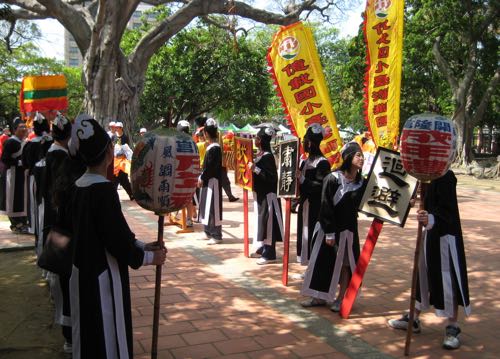Each of Taiwan’s cities and counties has at least one Confucian Temple, not to mention several other places of worship where Confucius is worshipped alongside popular deities such as Mazu and Guan Gong. But who was Confucius? The name of this educator and philosopher is known to every person of Chinese descent, wherever they are in the world. Confucius lived in what’s now northeastern China 2,500 years ago. His teachings are broadly conservative, yet stress moderation in most facets of human life. One of his core principles has become known as the Golden Rule: ‘What you do not wish for yourself, do not do to others.’
Until the beginning of the 20th century, Confucian thought was a key subject in the academies throughout China and Taiwan where young men prepared for the imperial examinations. Success in these could lead to an appointment in the imperial civil service, a career more prestigious than any other in traditional society.
Taiwan’s Confucian temples traditionally functioned as schools as well as places where the sage’s life and ideals were commemorated. It’s hardly surprising the very oldest is in Tainan, the city which for over 200 years was the island’s administrative centre. Tainan’s Confucius Temple was established in 1665. It’s truly a must-see: Not only are the buildings delightfully antiquated, but the gnarled trees which dot the forecourt exude a real sense of history.

Taiwan has two other especially notable Confucian temples. One is in Taipei, the other in Changhua near Taichung. Taipei’s Confucian shrine is relatively modern (it’s a 1925 reconstruction), and it contains a great deal of English-language information. What’s more, it’s a stone throw from another very worthwhile house of worship, Dalongdong Baoan Temple.
Compared to its counterparts in Taipei and Tainan, the Confucian Temple in Changhua City is visited by very few international tourists. It was founded in 1726, then expanded and rebuilt in 1830. The entire complex is extremely photogenic, and has an excellent collection of what are known in Chinese as bian. Each of these wooden tablets is inscribed with four (very occasionally five) characters full of auspicious meaning, and presented on behalf of a notable person. Among the bian hanging from the rafters of Changhua Confucius Temple are gifts from the Emperor Qianlong (reigned 1736 to 1796), and President Chiang Ching-kuo, the man who ruled Taiwan between 1978 and 1988, and oversaw its transition to multiparty democracy.

